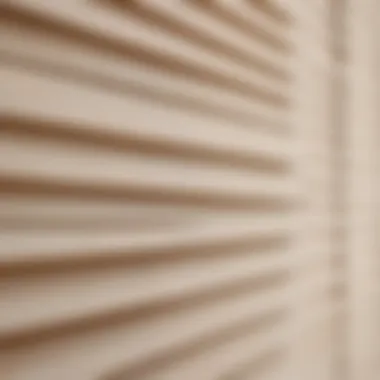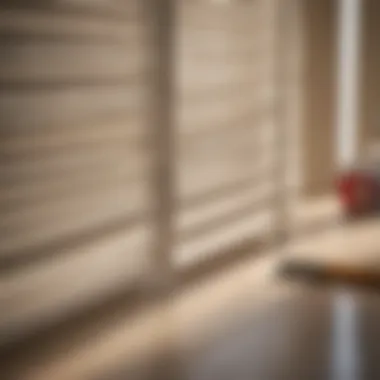A Complete Guide to Cleaning Paper Blinds Effectively


Intro
Cleaning paper blinds might seem like a mundane task, but understanding the essentials can transform this chore into a straightforward and efficient process. Though they may not carry the weight of heavy drapes or wooden shutters, paper blinds offer their own unique aesthetic appeal. They come in various styles and colors, providing homeowners with an inexpensive and versatile option for window coverings. However, their delicate nature means they can easily attract dust, stains, and other imperfections.
This guide aims to break down the nuances involved in maintaining paper blinds, addressing design principles alongside cleaning strategies. Recognizing how to balance the upkeep of these visually appealing elements with their practical use can elevate any space, ensuring your blinds not only look good but also last longer. With the right knowledge and tools, anyone can keep their paper blinds looking fresh and inviting.
The following sections will outline a structured approach to cleaning techniques, tips, and inspiration that enhance the overall beauty and functionality of your home. With a little bit of effort and care, paper blinds can retain their charm while remaining a practical part of your living space.
Understanding Paper Blinds
Understanding paper blinds is crucial for homeowners, designers, and even retailers wanting to enhance the atmosphere and functionality of indoor spaces. These blinds not only serve the practical purpose of light control and privacy but also contribute significantly to the aesthetic appeal of a room. By comprehending their characteristics, uses, and benefits, one can make informed decisions regarding their maintenance and upkeep, which is the core of this guide.
Definition and Characteristics
Paper blinds are window coverings crafted from various types of paper materials, including light-filtering options and thicker, privacy-oriented designs. They typically come in a variety of textures, patterns, and colors to suit different interior styles. One of the defining features of paper blinds is their lightweight nature, which allows for easy installation and adjustment.
Another characteristic worth noting is their environmental impact; many paper blinds are made from recycled materials or sourced sustainably, making them a go-to choice for eco-conscious consumers. However, despite their many advantages, these blinds have limitations; they are not as durable as fabric or wooden blinds and require careful handling to avoid damage.
Common Uses and Benefits
Paper blinds are increasingly popular for factors encompassing aesthetics, affordability, and versatility. Their light filtering ability ensures rooms have a warm and inviting atmosphere.
Common uses include:
- Residential Spaces: Ideal for bedrooms and living rooms where ambiance is key, enhancing decor while providing privacy.
- Commercial Settings: Many offices use them for meeting rooms or lounges due to their stylish appearance without breaking the bank.
- Workshops and Studios: Creatives find them useful because they balance natural light with reduced glare.
Benefits of using paper blinds include:
- Cost-Effectiveness: Generally, they come at a lower price point compared to alternatives.
- Customization Options: They can be found in countless designs to fit any interior style, lending themselves perfectly to personal expression.
- Ease of Cleaning and Maintenance: With the proper techniques outlined in this guide, maintaining paper blinds can be straightforward and effective.
As such, having a deeper understanding of paper blinds prepares one for the cleaning process, ensuring longevity and sustaining their appeal for years to come.
Why Cleaning Paper Blinds is Important
Cleaning paper blinds is a task often overlooked, yet understanding its significance can truly transform a living space. These window coverings are not just functional; they serve as a statement piece in your decor. A thorough cleaning regimen goes beyond just aesthetics; it also addresses health and safety concerns.
Impact on Aesthetics
When we talk about the visual appeal of your home, paper blinds play a pivotal role. They filter light beautifully while adding texture and depth to a room. However, dust, fingerprints, and other residues can accumulate over time, making them look worn and unattractive. And let's face it, no one wants guests to walk into a home that looks less than polished.
A few key points on how cleaning can enhance your blinds’ appearance include:
- Improved Light Filtering: Clean blinds allow more light to filter through, brightening up your space.
- Visual Clarity: Removing dust and grime prevents the buildup that obscures the design and color of the blinds, making them look vibrant.
- Greater Longevity: By regularly maintaining these window treatments, you prolong their lifespan, ensuring you won’t have to replace them sooner than expected.
Daily or weekly cleaning doesn’t necessarily have to be a monumental task. Sometimes a quick dusting while you tidy other parts of your home can go a long way.
"A clean set of blinds can make a home feel fresh, and who wouldn’t want that?"
Effect on Air Quality
Household dust isn’t just an aesthetic issue; it’s also a health one. Accumulated dust and allergens on paper blinds can negatively affect indoor air quality. This is especially concerning for individuals with allergies or respiratory conditions. Additionally, mold and mildew can ourish in damp conditions, making regular cleaning even more essential.
Consider these facts about air quality improvement:


- Dust Reduction: Regularly cleaning blinds removes dust particles that can circulate through the air, providing a cleaner breathing environment.
- Mold Prevention: Keeping blinds dry and well-maintained avoids mold buildup, which can lead to health complications.
- Enhanced Indoor Comfort: A space that’s free from allergens provides a more comfortable living experience for everyone.
In a nutshell, investing time in cleaning paper blinds is crucial for both how your home looks and the quality of air you breathe. Skipping this important task could lead to discomfort or even health issues. It’s a small price to pay for a healthier living space.
Preparation for Cleaning
Before diving into the cleaning process of paper blinds, it is crucial to prep the cleaning environment adequately. This not only helps to streamline the cleaning process but also ensures that no unnecessary damage occurs to your blinds. Proper preparation paves the way for a more effective and efficient cleaning routine. By following a few key steps, you can save time, reduce stress, and maintain the integrity of your blinds.
Gathering Essential Cleaning Supplies
To tackle the task of cleaning paper blinds, it's essential to have the right tools and cleaning agents at your disposal. Having the correct supplies not only impacts the ease of cleaning but also the overall effectiveness. Here’s a list of items to consider:
- Microfiber Cloths: These are gentle on paper and are excellent for picking up dust without scratching the surface.
- Feather Duster: A lightweight option for light dusting, perfect for reaching corners and high areas.
- Mild Soap Solution: A mixture of water and a gentle soap, like dish soap, works wonders for tough stains without damaging the material.
- Water Bottle and Spray Nozzle: Depending on the amount of moisture you need, a spray bottle can control the application effectively.
- Soft Sponge: For deeper cleaning, a soft sponge can be useful, especially for spot cleaning.
When gathering your supplies, make sure to avoid any harsh chemicals. Some cleaners can cause the paper to fray or discolor. Sticking to natural cleaning options is always a safe bet.
Assessing Condition of Blinds
Before starting your cleaning session, take a moment to assess the current state of your paper blinds. This step is crucial because it influences the cleaning technique you will choose. Here are some aspects to look for:
- General Cleanliness: Are your blinds just dusty, or do they have stubborn stains? Knowing this will help determine whether light dusting or a more extensive cleaning approach is needed.
- Damage Detection: Look for any signs of wear and tear, such as torn slats or fraying edges. Depending on the condition, you may need to handle the cleaning more cautiously to avoid causing further damage.
- Color and Fade: If the blinds appear discolored or faded, this could be a sign they have lost some of their protective finish. Knowing this can help you select appropriate cleaning techniques to avoid exacerbating the issue.
Taking these preparatory steps not only enhances the effectiveness of the cleaning process but also contributes to the longevity of your paper blinds.
Remember: Being thorough in your preparations can save you time in the long haul, letting you enjoy a clean and appealing environment without the hassle of repeating cleaning tasks in vain.
Methods for Cleaning Paper Blinds
Cleaning paper blinds requires specific methods as they are delicate and can be easily damaged. Knowing how to clean them properly not only helps in maintaining their aesthetic but also extends their lifespan. Dust and dirt can accumulate over time, creating a shabby appearance, while allergens can be trapped within the fibers. The approach taken during the cleaning process impacts both appearance and functionality.
Dusting Techniques
Using a Microfiber Cloth
Microfiber cloths have gained a reputation in the cleaning world for their remarkable ability to trap dust and dirt. This material is made of tiny fibers that are much finer than human hair, which helps in capturing particles rather than just pushing them around. Using a microfiber cloth for dusting paper blinds is a smart move as it is soft and non-abrasive. This ensures that you won’t accidentally scratch the surface or damage the material while cleaning.
The beauty of microfiber lies in its versatility. Rather than purchasing a bunch of specialized cleaners, many homeowners can simply dampen the cloth and wipe down the blinds. This method is environmentally friendly, reducing the need for chemical cleaners, which can sometimes be harsh on paper.
Employing a Feather Duster
Feather dusters are a classic choice for light cleaning, particularly when it comes to delicate items such as paper blinds. One may think of feather dusters as outdated or not serious enough, but they play an important role in a cleaning arsenal. Their soft feathers gently lift away dust without smudging or scratching the blinds. This characteristic is especially beneficial for those who prefer a more gentle approach to cleaning.
A notable feature of feather dusters is their ability to reach into the nooks and crannies of blinds. They can easily navigate the various slats without the need for strenuous scrubbing. Feather dusters can also be great for quick touch-ups, saving time on a busy day.
However, it’s important to remember that while feather dusters are great for routine dusting, they might not handle tougher dirt or stains. For deeply embedded grime or stickiness, you will need to follow up with more direct cleaning methods. Feather dusters shine during regular maintenance, making them a popular option for quick clean-ups.
Spot Cleaning Stains
Identifying Types of Stains
Stains on paper blinds can come from various sources, such as spilled drinks, food, or even marks left by fingers. Identifying the type of stain is crucial for selecting the right cleaning method, as not all stains react to the same treatments. For example, water stains differ significantly from grease stains and require different approaches.
This aspect of cleaning is pivotal, as misidentifying a stain can lead to ineffective cleaning, or worse yet, spreading the stain further. It is advantageous to know beforehand what you are dealing with; a few drops of lemon juice can work wonders on some stains, while a mixture of vinegar and water might suit others better. This flexibility is essential in maintaining the integrity of the blinds while ensuring they look their best.


Selecting Appropriate Cleaner
After pinpointing the type of stain, the next logical step is to choose a suitable cleaner. The good news is that there are many readily available options that cater to different kinds of stains. Whether it's a gentle dish soap mixed with warm water for mild stains, or a specialized cleaner for tougher spots, selecting the right product is key. It’s crucial to always do a patch test before proceeding to avoid causing damage.
The choice of cleaner can make or break the cleaning process. A cleaner that is too harsh may not only damage the finish of paper blinds, but also lead to discoloration. Conversely, a very mild solution may not suffice, leaving the stain intact. Thus, knowing the right cleaner to use based on the stain type enhances both effectiveness and care in the cleaning process.
Deep Cleaning Procedures
Using a Mild Soap Solution
Deep cleaning might seem daunting for paper blinds, but using a mild soap solution can simplify the task considerably. This method is excellent for removing built-up grime and dirt that dusting cannot reach. The key characteristic of a mild soap solution lies in its gentle nature; it can cleanse effectively without compromising the material.
Prepare your solution by mixing a small amount of dish soap with warm water. A soft cloth can then be dipped into this mixture and wrung out to ensure it’s not soaking wet. The advantage here is the dual force of cleanliness and protection; the soap helps to lift dirt without harming the surface. Your blinds can be revitalized and restored with minimal risk.
The caveat, as with all methods, is to ensure thorough drying afterward. Leaving moisture on the paper blinds could lead to issues down the line. Thus, a combination of careful application and drying is crucial for success.
Employing Water for Heavier Dirt
When dirt is really ground in, sometimes it takes a little extra effort to get paper blinds back to their prime. In these cases, simply using straight water can be surprisingly effective. One might think this sounds too simplistic, but sometimes all that’s needed is a gentle rinse followed by a camouflaged wipe with a damp cloth.
This strategy means not overloading the material with excessive water; moderation is the key. Using a damp cloth instead of soaking the blinds will allow you to lift dirt without fear of damage. This method is beneficial because it’s easy to execute and doesn’t require specialized products. For those mornings when a quick cleaning is necessary before guests arrive, this option shines.
However, similar to other cleaning methods, careful attention should be paid to drying the blinds properly. Any remaining moisture could lead to problems. Using a fan or some ventilation can ensure they dry properly and remain in great shape. Overall, employing water for heavy dirt can retain the fresh and clean look of your paper blinds with minimal fuss.
Drying and Maintaining Paper Blinds
Maintaining the condition of paper blinds involves more than just cleaning; it requires an understanding of proper drying techniques and routine maintenance strategies. This phase is crucial as it not only helps keep video blinds functional but also prolongs their lifespan. Understanding how to dry and maintain these blinds can make a world of difference, preventing unsightly damage while preserving their aesthetic appeal.
Proper Drying Techniques
When it comes to drying paper blinds after cleaning, there are two main practices that can be foundational: avoiding excess moisture and ensuring proper airflow. Both contribute significantly to preventing damage that might occur from improper drying methods.
Avoiding Excess Moisture
This aspect is particularly pivotal after cleaning. Paper blinds are usually made from materials like paper or fabric, which can absorb excess water. If not dried properly, they may warp or develop mold and mildew. For this reason, it is crucial to minimize moisture exposure.
The key characteristic of avoiding excess moisture is the method of drying itself. Instead of soaking or using excessive water during cleaning, consider using a lightly damp cloth for spot cleaning. This approach is beneficial as it reduces the chances of damaging the material. A unique feature of avoiding excess moisture is that it keeps the fibers intact, ensuring longevity in the structure.
However, one downside to this approach could be the prolonged drying time if the blinds are overly damp from the start. Nonetheless, ensuring paper blinds stay dry after cleaning is preferable to repairing or replacing them later.
Positioning for Airflow
Positioning blinds in a way that allows for proper airflow is another effective strategy. When paper blinds are hung outside (for example, on a clothesline or over a tub), they can dry quickly and thoroughly. This method relies on natural air circulation and can be done without any additional tools or hardware.
The main benefit of this technique is that it can help prevent the buildup of moisture that encourages mold growth. By allowing air to circulate around the blinds, you greatly enhance your chances of avoiding damp spots. The unique aspect of positioning for airflow is how it utilizes nature when possible; sometimes, the simplest method is the most effective.
However, a possible disadvantage could be exposure to dust and dirt if left out for too long. Thus, it’s vital to monitor their placement and ensuring they dry but not remain exposed for excessive periods.
Routine Maintenance Tips
Beyond drying, regular maintenance is fundamental in ensuring your paper blinds remain in good condition. Adopting a cleaning routine and protective measures goes a long way in extending the lifespan and maintaining their appearance.
Regular Dusting Schedule


Establishing a regular dusting schedule is an easy yet valuable practice. Dust can gather quickly, especially in homes with pets or lots of foot traffic. Having a systematic plan for dusting can significantly impact the overall maintenance process.
The key feature of a dusting schedule is you can easily customize it based on your living arrangements. For instance, homes with high dust accumulation might need attention every week, while others may fare fine with a once-a-month approach. This practice not only enhances the blinds' appearance but also assists in preventing the build-up of allergens, contributing to a healthier environment.
Yet, the potential downside here might be that it can be easily forgotten among other household chores. Consequently, integrating reminders into daily or weekly tasks may be helpful in establishing this habit.
Adopting Protective Measures
Protective measures, such as installing UV-filtering films or utilizing blinds that offer greater opacity, can serve as additional layers of defense against elements that threaten the integrity of paper blinds. Such installations protect against fading or getting damaged from sunlight.
One of the essential aspects of adopting protective measures is that they enhance both performance and functionality. For instance, if you opt for UV blinds, they can considerably reduce heat build-up while prolonging the lifespan of paper materials by reducing their exposure to potentially harmful UV rays.
The downside, however, is that some protective solutions may require professional installation or might be an additional investment initially. Weighing the long-term benefits against upfront costs will often lead to more educated decisions in terms of maintenance.
Effective maintenance can create an inviting atmosphere, whilst eliminating potential issues before they arise.
In essence, understanding both proper drying techniques and routine maintenance practices plays a significant role in the longevity of paper blinds. By implementing strategic approaches, homeowners can preserve the aesthetics and functionality of their paper blinds for many years.
Potential Issues and How to Address Them
When it comes to cleaning paper blinds, potential issues can crop up that may complicate the maintenance process. Understanding these issues is crucial for ensuring the longevity and aesthetic appeal of your blinds. The unaddressed problems can lead to deterioration, affecting both your blinds and the overall ambiance of your space. If the blinds show signs of wear and tear, knowing how to manage these challenges is equally important as knowing how to clean them.
Dealing with Fading and Discoloration
Fading or discoloration of paper blinds can occur for several reasons. One of the primary culprits is sunlight exposure. Over time, UV rays can bleach the fibers in the paper, leading to a washed-out look. Additionally, dust and dirt can settle on the surface, causing uneven fading that detracts from the original design and color.
How to Address Fading:
- Limit Sunlight Exposure: Consider using sheer curtains or other forms of window coverings to protect your paper blinds from excessive sunlight.
- Regular Dusting: Establishing a routine for dusting can help maintain colors by removing buildup before it becomes a bigger problem. Use a microfiber cloth or a gentle vacuum attachment for this.
- Spot Treatments: If you see specific areas that are particularly faded, a mild soap solution can sometimes revitalize the appearance. Just be sure to test any solution on an inconspicuous area first.
Pro Tip: Use a window film to reduce UV exposure while still allowing natural light in, protecting the integrity of your paper blinds.
Managing Structural Damage
Structural damage to paper blinds is often more serious than surface-level issues and can significantly affect functionality. Tears and bent slats can be caused by mishandling during cleaning or simply through regular use. Environmental factors, such as high humidity or heavy winds, can also lead to warping.
How to Address Structural Damage:
- Assess the Damage Regularly: Frequent checks can help you catch small issues before they evolve into larger problems. Look for any twists, bends, or fractures in the paper.
- Simple Repairs: Small tears can often be fixed with a bit of tape or adhesive specifically formulated for paper products. Make sure the adhesive is compatible to avoid further damage.
- Replacement: For extensive damage, replacing the blinds may be the more practical solution. Consider this when repairs prove costlier than new blinds.
Culmination
Cleaning paper blinds might seem like a small yardstick in the realm of home maintenance, yet it holds considerable weight. Not only does this care preserve the aesthetic appeal of these often-overlooked fixtures, but it also plays a significant role in promoting a healthier living space. Paper blinds gather dust, allergens, and grime, which can aggravate allergies or respiratory issues. Thus, maintaining them isn’t just about appearances; it’s about fostering a clean, welcoming environment.
Summary of Key Cleaning Techniques
When it comes to keeping your paper blinds in tip-top shape, a few key strategies stand out:
- Routine Dusting: A simple wipe with a microfiber cloth can do wonders. Regularly removing dust prevents buildup and helps maintain their color and feel.
- Spot Cleaning Stains: Stains happen—whether it's from spilled drinks or curious pet paws. Identifying the stain type and using the right cleaner preserves the integrity of the paper.
- Deep Cleaning: Occasionally, a more thorough clean is necessary. A mild soap solution can refresh weary blinds and combat stubborn dirt, ensuring they shine anew.
Each of these techniques emphasizes the balance between protective measures and practical cleaning approaches. Shovel this knowledge into daily household routines, and you’ll find your paper blinds fare much better over time.
Final Thoughts on Maintenance Practices
Integrating a few straightforward maintenance practices can significantly extend the lifespan of your paper blinds. Consider the following:
- Controlled Environment: Keeping blinds out of direct sunlight can prevent fading and prolong their life.
- Seasonal Check-ups: Assessing the condition seasonally can help catch potential issues early, allowing for prompt action before they escalate.
- Protective Measures: Implementing simple barriers, such as sheer curtains or treatments that filter out UV rays, can reduce wear and tear.
In summary, the journey of cleaning and maintaining paper blinds is not merely arduous labor; it’s an act of preservation—of beauty, health, and the very essence of your home. The small efforts you put in today will repay you with aesthetics that endure through the years, fostering an ambiance within your space that feels fresh and inviting.















